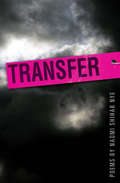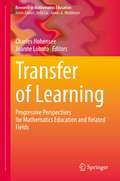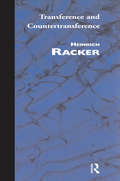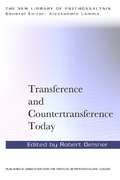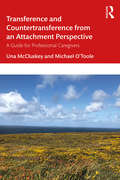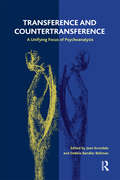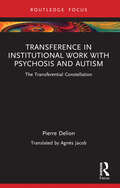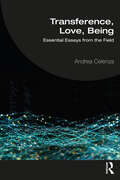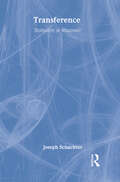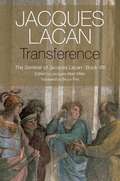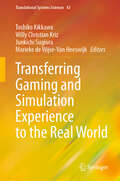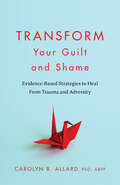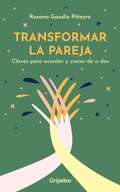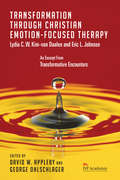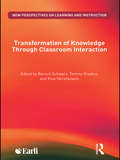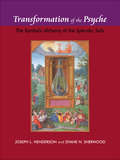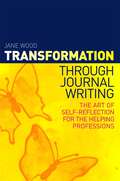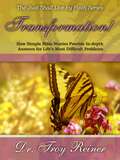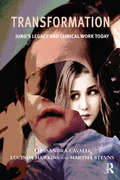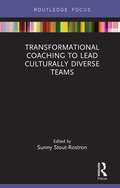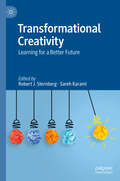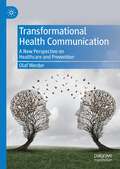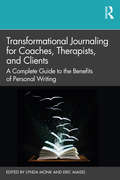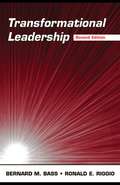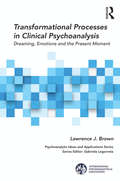- Table View
- List View
Transfer
by Naomi Shihab NyeNaomi Shihab Nye has spent thirty-five years traveling the world to lead writing workshops and inspire students of all ages. In her newest collection Transfer, she draws on her Palestinian American heritage, the cultural diversity of her home in Texas, and her extensive travel experiences to create a poetry collection that attests to our shared humanity. Among her awards, Naomi Shihab Nyehas been a Lannan Fellow, a Guggenheim Fellow, and a Witter Bynner Fellow. She has received a Lavan Award from the Academy of American Poets, the Isabella Gardner Poetry Award, the Paterson Poetry Prize, and four Pushcart prizes. In January 2010, she was elected to the board of chancellors of the Academy of American Poets.
Transfer of Learning: Progressive Perspectives for Mathematics Education and Related Fields (Research in Mathematics Education)
by Charles Hohensee Joanne LobatoThis book provides a common language for and makes connections between transfer research in mathematics education and transfer research in related fields. It generates renewed excitement for and increased visibility of transfer research, by showcasing and aggregating leading-edge research from the transfer research community. This book also helps to establish transfer as a sub-field of research within mathematics education and extends and refines alternate perspectives on the transfer of learning. The book provides an overview of current knowledge in the field as well as informs future transfer research.
Transference and Countertransference
by Heinrich RackerThis book presents a classic examination of transference phenomena and focuses on the development of psychoanalytic technique and theory. It addresses a perceived gap between psychoanalytic knowledge and its capacity to effect psychological transformation in a patient.
Transference and Countertransference Today (The New Library of Psychoanalysis)
by Robert OelsnerWhy has Heinrich Racker’s original work on transference and countertransference proven so valuable? With a passionate concern for the field created by the meeting of analyst and patient, and an abiding interest in the central importance of transference and countertransference in analytic practice, Robert Oelsner has brought together the thought and work of seventeen eminent analysts from Europe, the United States, and Latin America. In new essays commissioned for this volume, the writers have set aside the lines that can often divide psychoanalytic groups and schools in order to examine in depth the variety of approaches and responses that characterize the best analytic practice today. The result is a collection of fresh, contemporary material centred on the two interrelated subjects – transference and countertransference – that make up the core of psychoanalytic work. Both in the clarity of their language and in moving clinical examples the writers reveal, in distinctively personal ways, how Heinrich Racker’s original thought, which brought the analyst’s unconscious responses into the equation, has allowed them to evolve their own perspectives. Yet it is particularly interesting to find unexpected parallels among the chapters that point toward a shared vision. Clearly, whether in work with adults or children, transference and countertransference are now seen as encompassing a field that embraces both participants in the consulting room. Making Transference and Countertransference Today still more valuable as a resource for teachers and students are several major contributions by authors whose work is not otherwise readily available in English. Psychoanalysts and others will find few other books that present such a thoughtful picture of these crucial and fascinating analytic topics.
Transference and Countertransference from an Attachment Perspective: A Guide for Professional Caregivers
by Una McCluskey Michael O'TooleLocating the phenomenon of transference within an evolutionary perspective, this important book develops a new form of dynamic therapy that focuses on the dynamics of attachment in adult life and will be of use to a range of mental health professionals and those at all levels in the caring and education professions. Transference and Countertransference from an Attachment Perspective: A Guide for Professional Caregivers explores the ways in which transferential phenomena can be located in the different aspects of the self that are instinctive, goal-corrected and interrelated. At the centre of the book is the idea that when intrapersonal or interpersonal systems (aspects of the self, such as careseeking, caregiving, sharing interests, sexuality, self-defence, building a home) get aroused, the behaviour that follows is only logically and meaningfully connected when the system (aspect of the self) reaches its goal. Placing this new theoretical and clinical approach within the psychoanalytic tradition, the work of developmental psychologists and the field of neuroscience, the book takes us to the heart of the clinical encounter and explores a range of issues including trauma, the effect of early misattunements, love and hate in the therapeutic relationship, burnout in caregivers, and the need for exploratory care for caregivers themselves. Building on the therapeutic modality that emerged from the research described in McCluskey's To Be Met as a Person (2005), this book provides a valuable guide for psychologists, psychotherapists, medical practicioners, nurses, social workers, organisational consultants, educators, coaches, and workplace managers. The McCluskey model for exploring the dynamics of attachment in adult life which underlies the work described in this book is currently being practised in a variety of settings and with different ages and communities. These include end-of-life care, organizations, homelessness, mental health, dementia care, children, adolescents and families, schools, pastoral work, training of clinical psychologists and attachment-based psychoanalytic psychotherapists, occupational therapy, art therapy, private practice, domestic violence, police training, GP support and consultation, nurse training and support, pain management clinics, foster carers, social workers, couple relationships, supervision of psychotherapists and counsellors, therapeutic communities, and complex grief and learning disabilities.
Transference and Countertransference: A Unifying Focus of Psychoanalysis
by Jean Arundale Debbie Bandler BellmanSince Freud's initial papers on transference and countertransference, these vast and inexhaustible subjects have occupied psychoanalysts. Transference and countertransference, the essence of the patient/analyst relationship, are concepts so central to pschoanalysis that, to our minds, they transcend theoretical orientation and, thus, can be seen as a unifying focus of psychoanalysis. However differently theoretical traditions conceptualize the transference, or disagree as to when and how to interpret it in our everyday analytic work, we all embrace the phenomenon as vital to psychic change.
Transference in Institutional Work with Psychosis and Autism: The Transferential Constellation (Routledge Focus on Mental Health)
by Pierre DelionTransference in Institutional Work with Psychosis and Autism presents Pierre Delion’s extensive experience in psychiatric institutions, focusing on the concept of the transferential constellation. Delion first discusses the pioneering work of François Tosquelles at the Saint Alban psychiatric hospital, which enabled psychoanalytic treatment to be applied in cases of severe psychopathologies. The book then explains how the transferential constellation can provide a deeper and more effective understanding of a patient’s needs by engaging all caregivers within an organisation over the course of the patient’s treatment history. Delion describes how regular meetings of all the team participants allow them to express different and even divergent views of the patient and to appreciate their complementary contributions to the institution. The transferential constellation is presented as an important development in the history of patient-centered psychiatric care and a touchstone for its ongoing humanistic development. Transference in Institutional Work with Psychosis and Autism will be of great interest to psychiatrists and psychotherapists in practice and in training. It will also be key reading for other practitioners and caregivers working in mental health institutions.
Transference, Love, Being: Essential Essays from the Field
by Andrea CelenzaThrough a series of expansive essays, Transference, Love, Being explores the centrality of love in psychoanalytic practice. Starting with the immersion of the analyst, this book reimagines several aspects of the psychoanalytic process, including transference, countertransference, boundaries, embodiment, subjectivity and eroticism. To love is to cultivate to be. Psychoanalysis, as essentially vitalizing, is a playspace for taboo subjects within clear and safe parameters. Interweaving loving, being and perceiving, this book provides challenging new perspectives on the analysts's subjectivity, receptivity and its immersive influence on the analytic process. These essays refine theoretical understandings of the irreducible and omnipresent nature of love in psychoanalysis, thereby offering clarity to psychoanalysts, psychodyanmic therapists and scholars through the often-prohibited love and eroticism, here viewed as indispensible psychoanalytic theory and practice.
Transference: Shibboleth or Albatross?
by Joseph SchachterThe theory of transference and the centrality of transference interpretation have been hallmarks of psychoanalysis since its inception. But the time has come to subject traditional theory and practice to careful, critical scrutiny in the light of contemporary science. So holds Joseph Schachter, whose Transference: Shibboleth or Albatross? undertakes this timely and thought-provoking task. After identifying the weaknesses and inconsistencies in Freud's original premises about transference, Schachter demonstrates how contemporary developmental research across a variety of domains effectively overturns any theory that posits a linear deterministic relationship between early childhood and adult psychic functioning, including the adult patient's treatment behavior toward the analyst. No less trenchantly, he shows how contemporary chaos theory complements developmental research by making the very endeavor of historical reconstruction - of backward prediction - suspect on logical grounds. Nor, Schacter continues, does the clinical evidence normally adduced in support of transference theory provide the firm bedrock of data that most analysts suppose to exist. What one finds, he holds, are endlessly reiterated claims of identifying determining historical antecedents sustained only by descriptions of current behaviors through a gloss of theory. Less a polemic than a call to order, Transference: Shibboleth or Albatross? is cogently argued and straightforwardly written. It is destined to be a thorn in the side of analysts who resist change and a spur to those who seek to bring analytic theory into closer alignment with contemporary science in the interest of improves treatment efficacy.
Transference: The Seminar of Jacques Lacan Book VII
by Bruce Fink Jacques Lacan Jacques-Alain MillerLectures on Transference in Psychoanalysis.
Transferring Gaming and Simulation Experience to the Real World (Translational Systems Sciences #43)
by Willy Christian Kriz Toshiko Kikkawa Junkichi Sugiura Marieke de Wijse-van HeeswijkThis book focuses on how to connect the gaming experience to the real world. Looking back at the history of the Simulation and Gaming field, it has offered the solution to social problems such as policy making, decision making for business strategies, education and training, environmental issues, urban planning, or disaster awareness. In other words, Gaming Simulation always has had a close connection to the reality. The interconnected modern societies nowadays have become even more complex and ambiguous, as the UN SDGs goals show. Gaming is one of the suitable tools to suggest ways to achieve our goals in a world of uncertainty. Learning starts by experiencing games and their effects in a safe environment. An important part of the gaming simulation process are methods for a transfer of the game-based learning to and an application within reality. However, connecting the experience to reality is not always facile for all the participants, no matter how comprehensive the debriefing is. In addition to debriefing, further transfer methods and conditions have to be implemented in order to create a real change of behavior and systems. The book's authors tackle the challenge by introducing concrete practices and offering various hints for readers struggling to solve a similar issue. In addition, when applying the experience of gaming, we have to carefully consider several ethical issues, which are also covered in this book.
Transform Your Guilt and Shame: Evidence-Based Strategies to Heal From Trauma and Adversity
by Carolyn B. AllardThis book provides scientifically proven strategies for reducing guilt and shame associated with trauma and adversity. Automatic reactions help us survive dangerous situations. Whether we are fighting to fend off an attacker, fleeing an explosion, or freezing to maintain attachment with an abusive parent upon whom we are dependent, our hard‑wired reactions keep us safe during intensely stressful times. But these automatic responses can be followed by guilt and shame, which can linger long after the traumatic events, making us anxious, avoidant, overreactive, irritable, depressed, angry, or passive. And these symptoms, in turn, can lead to more guilt and shame, which lead to more problematic coping behaviors, in a continuing cycle. This book helps readers learn to transform their unhealthy guilt and shame by identifying and changing their ways of thinking and acting that may have been adaptive in a past situation but are now keeping them stuck in this unhealthy cycle. In particular, it focuses on five categories of thought that contribute to problematic guilt and shame and shows readers how to recognize and challenge these thoughts. Each chapter contains straightforward written exercises that guide readers through the transformation process, as well as relatable examples for illustration. Grounded in research-supported cognitive behavior therapy principles, this book will help readers break free from survival‑based reactivity and regain control over their lives.
Transformar la pareja: Claves para acordar y crecer de a dos
by Roxana Gaudio«Un libro necesario, que estoy seguro ayudará a muchos a cuidarse a sí mismos, cuidando al otro.» Alejandro De Barbieri ¿Estamos juntos cuando estamos juntos? El paradójico sentimiento de desamparo que genera el estar en pareja, pero viviendo la soledad más profunda, es más frecuente de lo que creemos. El modo de relacionarnos está en crisis y con ello la salud de las parejas. ¿Qué pido y qué doy? ¿Cómo se perdió el amor? ¿Construimos una vida juntos o una empresa? ¿Cuándo se está a tiempo de recuperar la pareja? ¿Cuáles son las fuerzas que están operando en contra? ¿Qué herramientas tengo a mi alcance para sanarla? ¿Es posible recobrar la mística del encuentro con el otro? Estas y tantas otras inquietudes son las que a diario recibe la autora, tras veinte años de consulta con personas que sufren, temen, se lamentan y se sienten a la deriva, ahogados entre culpas y recriminaciones, sin ver una salida. La psicóloga especializada en logoterapia Roxana Gaudio vuelca en estas páginas casos reales y ejercicios prácticos para proponer aprendizajes y desafíos. Quienes tienen dificultades en la pareja -cualquiera sea su tipo-, se sienten al borde de la ruptura o les interesa cultivar la relación que llevan encontrarán en este libro una pausa para mirarse y una guía para sanar ese vínculo tan preciado.
Transformation Through Christian Emotion-Focused Therapy: Chapter 10, Transformative Encounters
by Eric L. Johnson Lydia C. DaalenTransformative Encounters,The Rebuilding of Psychology
Transformation of Knowledge through Classroom Interaction (New Perspectives on Learning and Instruction)
by Tommy Dreyfus Baruch Schwarz Rina HershkowitzClassrooms provide extremely varied settings in which learning may take place, including teacher-led conversations, small group unguided discussions, individual problem solving or computer supported collaborative learning (CSCL). Transformation of Knowledge through Classroom Interaction examines and evaluates different ways which have been used to support students learning in classrooms, using mathematics and science as a model to examine how different types of interactions contribute to students’ participation in classroom activity, and their understanding of concepts and their practical applications. The contributions in this book offer rich descriptions and ways of understanding how learning occurs in both traditional and non-traditional settings. Combining theoretical perspectives with practical applications, the book includes discussions of: the roles of dialogue and argumentation in constructing knowledge the role of guidance in constructing knowledge abstracting processes in mathematics and science classrooms the effect of environment, media and technology on learning processes methodologies for tracing transformation of knowledge in classroom interaction. Bringing together a broad range of contributions from leading international researchers, this book makes an important contribution to the field of classroom learning, and will appeal to all those engaged in academic research in education.
Transformation of the Psyche: The Symbolic Alchemy of the Splendor Solis
by Joseph L. Henderson Dyane N. SherwoodWritten by Joseph L. Henderson, one of the first generation of Jungian analysts, and Dyane N. Sherwood, a practising analyst, this book is a striking and unique contribution to the resurgence of interest in alchemy for its way of representing the phenomenology of creative experience. Transformation of the Psyche is organized around 22 illuminated paintings from the early Renaissance alchemical manuscript the Splendor Solis, and is further illustrated by over 50 colour figures. The images of the Splendor Solis are possibly the most beautiful and evocative alchemical paintings to be found anywhere, and they are widely known to students of alchemy. Jung reproduced several Splendor Solis images in his works, yet prior to this book no one has explored the symbolism of the paintings as a series in relation to the process of depth psychological transformation. This book is the first scholarly study of the paintings in their entirety, and of the mythological and historical allusions contained within the images. Transformation of the Psyche does not simply explain or analyze the pictures, but invites the reader to participate in the creative and transforming process evoked by these images.Transformation of the Psyche is a truly unique book that will be of immense value and interest to analysts and psychotherapists, as well as scholars of mediaeval and renaissance intellectual history and students of spiritual disciplines.
Transformation through Journal Writing: The Art of Self-Reflection for the Helping Professions
by Jane WoodTransformation through Journal Writing is a grounded guide to self reflection through journaling for those in the helping professions. Journals are shown to be an effective method of self-care and self-development. Full of inspiring and original ideas, this book provides everything you need to know about developing and advancing journaling skills. It covers a range of different styles, from the logical and structured use of templates, frameworks and models, to the creative and organic process of art journaling. Each technique and its transformative potential are clearly explained, and readers are encouraged to start writing through expertly crafted exercises and journal examples. It is a flexible resource that will inspire readers to start a reflective journal for the first time or to try out new techniques and methodologies. A comprehensive handbook to self-reflective journaling, this book will be of interest to everyone in the health professions including complementary and alternative practitioners, supervisors, counsellors, psychotherapists, and art, music and drama therapists.
Transformation!: How Simple Bible Stories Provide In-Depth Answers for Life's Most Difficult Problems
by Troy ReinerOur society and churches are facing an increasing number of dysfunctional and emotionally hurting people with difficult, long-term psychological problems. Healing for these problems requires more than a few words of advice or some solution-focused therapy; it requires a life transformation. Unfortunately, most pastors and church counselors do not have in-depth Biblical answers for these complex problems. Consequently, most churches refer these problems to counselors outside of the church who rely primarily on secular counseling methods and theories, or psychoactive drugs. What is needed is a simple, yet in-depth, Biblical method for overcoming these complex problems that can be easily applied by pastors and counselors within the church. <p><p>This book provides just such a method with a new narrative Biblical approach for therapy and in-depth answers for counseling many of these difficult problems. This new method is developed directly from the Bible, relies on the overall direction of the Holy Spirit, and is based on Biblical truth derived from the stories of the lives of well-known Biblical characters. The final conclusion of this book is that God has provided in His word, through the types and shadows interpretation of these stories, all that is required to meet these desperate needs. <p><p>This book contains many new insights including a comprehensive plan for Christian counseling derived directly from the Bible, in-depth biblical answers for complex psychological problems based on the types and shadows interpretation of biblical stories, models and quick reference guides for counseling 20 of the most difficult problems in the church today including inferiority, abandonment, dysfunctional families, setting boundaries, six types of codependency, abuse, four types of addictions, bitterness, depression, grief, and suicide.
Transformation: Jung's Legacy and Clinical Work Today
by Alessandra Cavalli Lucinda Hawkins Martha StevnsThis book offers a challenging reading of the legacy of C.G. Jung, who offered fascinating insights into the psyche. It is intended for clinicians of different schools who are interested in a deeper understanding of the relationship between patient and analyst.
Transformational Coaching to Lead Culturally Diverse Teams (Routledge Focus on Coaching)
by Sunny Stout-RostronIn this book, Dr Sunny Stout-Rostron examines real-world experience and the contemporary literature on group and team coaching. She analyses how team coaching can guide coaches to help leaders and teams flourish in complex, culturally diverse organisations. As well as presenting a variety of team coaching models she also presents her own model, High-Performance Relationship Coaching, the result of many years of working with global corporate teams. Dr Stout-Rostron illuminates how team coaches can help teams to learn from and interpret their own experiences, and to understand the complexity of the environment in which they work. Her team coaching model is explored over eight chapters, beginning with the role of the business team coach and leadership coaching processes. She evaluates how to work in the Fourth Industrial Revolution and how to shift culture through transformative leadership coaching, explains the depth of relationship systems coaching, and explores how to apply a variety of methods including Ubuntu coaching. The book encourages team coaches to develop deep self-awareness, team awareness, cultural diversity awareness and wider systemic and relationship awareness. Filled with practical stories and examples, it describes how to work successfully with these models in the real world. Transformational Coaching to Lead Culturally Diverse Teams is a key guide for coaches in practice and in training, HR and L&D professionals and executives in a coaching role. This is essential reading for all team coaches.
Transformational Creativity: Learning for a Better Future
by Robert J. Sternberg Sareh KaramiThis edited volume brings together leading scholars in diverse disciplines to share their best thinking on how creativity can be conceived of, taught for, and deployed to serve rather than undermine humanity. Transformational creativity, as defined in this book, is creativity deployed to make a positive, meaningful, and potentially enduring difference to the world. Transformational creativity is compared to transactional creativity, which is creativity deployed in search of a reward, whether externally or internally generated.
Transformational Health Communication: A New Perspective on Healthcare and Prevention
by Olaf WerderThis book advances our understanding of communicative relationships and key barriers to more effective health communication. In this, it offers a humanistic orientation of health communication as well as its social, cultural, political, ethical, and spiritual dimensions and contexts. The book therefore brings a more inclusive and integrated approach to the major challenges and opportunities in contemporary health, medicine, and wellbeing.
Transformational Journaling for Coaches, Therapists, and Clients: A Complete Guide to the Benefits of Personal Writing
by Lynda Monk; Eric MaiselIn Transformational Journaling for Coaches, Therapists, and Clients: A Complete Guide to the Benefits of Personal Writing, more than 50 coaches, therapists, and journaling experts from around the world share their best practices and explain in detail how they use journaling to improve their work with clients. This edited collection brings together the leading voices of the journaling world into one ground-breaking volume, providing practical techniques and tools to use with clients. Applicable and accessible, over 50 journaling luminaries share their experiences and insights across eight sections, including the logic of journaling, techniques and applications, using journaling with clients, journaling in groups, journaling for mental health and wellness, growth and healing, spirituality, creativity, and more. Through theoretical and practical applications, it illustrates the transformational process of journaling in helping clients grow, heal, and achieve their goals. This book is essential reading for coaches, therapists, and other mental health professionals, as well as those interested in using personal writing for growth and self-awareness.
Transformational Leadership: A Comprehensive Review Of Theory And Research
by Bernard M. Bass Ronald E. RiggioTransformational Leadership, Second Edition is intended for both the scholars and serious students of leadership. It is a comprehensive review of theorizing and empirical research that can serve as a reference and starting point for additional research on the theory. It can be used as a supplementary textbook in an intense course on leadership--or as a primary text in a course or seminar focusing on transformational leadership.New in the Second Edition:*New, updated examples of leadership have been included to help illustrate the concepts, as well as show the broad range of transformational leadership in a variety of settings.*New chapters have been added focusing specifically on the measurement of transformational leadership and transformational leadership and effectiveness.*The discussion of both predicators and effects of transformational leadership is greatly expanded.*Much more emphasis is given to authentic vs. inauthentic transformational leadership.*Suggestions are made for guiding the future of research and applications of transformational leadership.*A greatly expanded reference list is included.
Transformational Processes in Clinical Psychoanalysis: Dreaming, Emotions and the Present Moment (The International Psychoanalytical Association Psychoanalytic Ideas and Applications Series)
by Lawrence J. BrownIn this book, Lawrence J. Brown offers a contemporary perspective on how the mind transforms, and gives meaning to, emotional experience that arises unconsciously in the here-and-now of the clinical hour. Brown surveys the developments in theory and practice that follow from Freud’s original observations and traces this evolution from its conception to contemporary analytic field theory. Brown emphasizes that these unconscious transformational processes occur spontaneously, in the blink of an eye, through the "unconscious work" in which the analyst and patient are engaged. Though unconscious, these processes are accessible and the analyst must train himself to become aware of the subtle ways he is affected by the patient in the clinical moment. By paying attention to one’s reveries, countertransference manifestations and even supposed "wild" or extraneous thoughts, the analyst is able to obtain a glimpse of how his unconscious is transforming the ambient emotions of the session in order to formulate an interpretation. Brown casts a wide theoretical net in his exploration of these transformational processes and builds on the contributions of Freud, Theodor Reik, Bion, Ogden, the Barangers, Cassorla, Civitarese and Ferro. Bion’s theories of alpha function, transformations, dreaming and his clinical emphasis on the present moment are foundational to this book. Brown’s writing is clear and aims to describe the various theoretical ideas as plainly as possible. Detailed clinical material is given in most chapters to illustrate the theoretical perspectives. Brown applies this theory of transformational processes to a variety of topics, including the analyst’s receptivity, countertransference as transformation, the analytic setting, the paintings of J.M.W. Turner, "autistic transformations" and other clinical situations in the analysis of children and adults. Transformational Processes in Clinical Psychoanalysis will be of great interest to all psychoanalysts and psychoanalytic psychotherapists.
